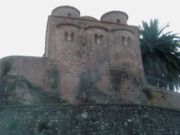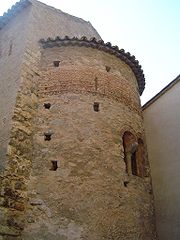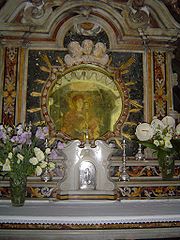
Rossano
Encyclopedia
Rossano is a town and comune
in Southern Italy
, in the province of Cosenza
(Calabria). The city is situated on an eminence c. 3. km from the Gulf of Taranto
. The town is known for its marble
and alabaster
quarries
.
The town is the seat of a Catholic
archbishop
and has a notable cathedral and castle. Two Popes have been born in the town, along with Saint Nilus the Younger.
 Roscianum was the original name of the town under the Roman Empire. In the 2nd century AD, emperor Hadrian
Roscianum was the original name of the town under the Roman Empire. In the 2nd century AD, emperor Hadrian
built or rebuilt a port here, which could accommodate up to 300 ships. It was mentioned in the Antonine itineraries, as one of the important fortresses of Calabria. The Goths of Alaric I
and, in the following century, Totila
, were unable to take it.
The Rossanesi showed great attachment to the Byzantine Empire
, whose local strategos had his seat here. The Rossano Gospels
, a 6th Century illuminated manuscript of great historical and artistic value, is a tangible relic of that period.
The Saracens failed to conquer Rossano, while in 982 Otto II captured it temporarily from the Byzantines. Its Greek character was preserved long after its conquest by the Normans, as noted by its long retention of the Greek Rite over the Latin Rite. The city in fact maintained notable privileges under the subsequent Hohenstaufen
and Angevine dominations, but subsequently decayed after the feudalization
in 1417.
Passing to the Sforza, and thus to Sigismund of Poland, it was united in 1558 to the crown of Naples
by Philip II of Spain
in virtue of a doubtful will by Bona Sforza
, queen of Poland in favor of Giovanni Lorenzo Pappacoda. Under Isabella of Naples
and Bona, the town had been a centre of literary culture; but under the Spaniards it declined.
In 1612, the crown sold the lordship to the Aldobrandini
, and in 1637, it passed to the Borghese
who retained it until 1806. The city was part of the Neapolitan Republic of 1799, but its conditions did not improve after the Unification of Italy, and much of the population emigrated
.
Rossano was the birthplace of Pope John VII
and Pope Urban VII
. Rossano is also the birthplace of Saint Nilus the Younger
, who founded the Abbey of Grottaferrata, and whose "Life" is a valuable source of information about southern Italy in the Tenth Century.

Outside the city are:

, Lamezia Terme
or Reggio Calabria
through SS. 106 Ionica Route. Rossano has a railway station on the secondary branch starting from Sibari, on the line to Crotone.
Comune
In Italy, the comune is the basic administrative division, and may be properly approximated in casual speech by the English word township or municipality.-Importance and function:...
in Southern Italy
Italy
Italy , officially the Italian Republic languages]] under the European Charter for Regional or Minority Languages. In each of these, Italy's official name is as follows:;;;;;;;;), is a unitary parliamentary republic in South-Central Europe. To the north it borders France, Switzerland, Austria and...
, in the province of Cosenza
Province of Cosenza
The Province of Cosenza is a province in the Calabria region of Italy. Its capital is the city of Cosenza.It has an area of 6,650 km², and a total population of 733,797 . It is the biggest Calabrian Province...
(Calabria). The city is situated on an eminence c. 3. km from the Gulf of Taranto
Gulf of Taranto
The Gulf of Taranto is a gulf of the Ionian Sea, in southern Italy.The Gulf of Taranto is almost square, 140 km long and wide, and is delimited by the capes Santa Maria di Leuca and Colonna...
. The town is known for its marble
Marble
Marble is a metamorphic rock composed of recrystallized carbonate minerals, most commonly calcite or dolomite.Geologists use the term "marble" to refer to metamorphosed limestone; however stonemasons use the term more broadly to encompass unmetamorphosed limestone.Marble is commonly used for...
and alabaster
Alabaster
Alabaster is a name applied to varieties of two distinct minerals, when used as a material: gypsum and calcite . The former is the alabaster of the present day; generally, the latter is the alabaster of the ancients...
quarries
Quarry
A quarry is a type of open-pit mine from which rock or minerals are extracted. Quarries are generally used for extracting building materials, such as dimension stone, construction aggregate, riprap, sand, and gravel. They are often collocated with concrete and asphalt plants due to the requirement...
.
The town is the seat of a Catholic
Catholic
The word catholic comes from the Greek phrase , meaning "on the whole," "according to the whole" or "in general", and is a combination of the Greek words meaning "about" and meaning "whole"...
archbishop
Archbishop
An archbishop is a bishop of higher rank, but not of higher sacramental order above that of the three orders of deacon, priest , and bishop...
and has a notable cathedral and castle. Two Popes have been born in the town, along with Saint Nilus the Younger.
History

Hadrian
Hadrian , was Roman Emperor from 117 to 138. He is best known for building Hadrian's Wall, which marked the northern limit of Roman Britain. In Rome, he re-built the Pantheon and constructed the Temple of Venus and Roma. In addition to being emperor, Hadrian was a humanist and was philhellene in...
built or rebuilt a port here, which could accommodate up to 300 ships. It was mentioned in the Antonine itineraries, as one of the important fortresses of Calabria. The Goths of Alaric I
Alaric I
Alaric I was the King of the Visigoths from 395–410. Alaric is most famous for his sack of Rome in 410, which marked a decisive event in the decline of the Roman Empire....
and, in the following century, Totila
Totila
Totila, original name Baduila was King of the Ostrogoths from 541 to 552 AD. A skilled military and political leader, Totila reversed the tide of Gothic War, recovering by 543 almost all the territories in Italy that the Eastern Roman Empire had captured from his Kingdom in 540.A relative of...
, were unable to take it.
The Rossanesi showed great attachment to the Byzantine Empire
Byzantine Empire
The Byzantine Empire was the Eastern Roman Empire during the periods of Late Antiquity and the Middle Ages, centred on the capital of Constantinople. Known simply as the Roman Empire or Romania to its inhabitants and neighbours, the Empire was the direct continuation of the Ancient Roman State...
, whose local strategos had his seat here. The Rossano Gospels
Rossano Gospels
The Rossano Gospels, designated by 042 or Σ , ε 18 , at the Cathedral of Rossano in Italy, is a 6th century illuminated manuscript Gospel Book written following the reconquest of the Italian peninsula by the Byzantine Empire...
, a 6th Century illuminated manuscript of great historical and artistic value, is a tangible relic of that period.
The Saracens failed to conquer Rossano, while in 982 Otto II captured it temporarily from the Byzantines. Its Greek character was preserved long after its conquest by the Normans, as noted by its long retention of the Greek Rite over the Latin Rite. The city in fact maintained notable privileges under the subsequent Hohenstaufen
Hohenstaufen
The House of Hohenstaufen was a dynasty of German kings in the High Middle Ages, lasting from 1138 to 1254. Three of these kings were also crowned Holy Roman Emperor. In 1194 the Hohenstaufens also became Kings of Sicily...
and Angevine dominations, but subsequently decayed after the feudalization
Feudalism
Feudalism was a set of legal and military customs in medieval Europe that flourished between the 9th and 15th centuries, which, broadly defined, was a system for ordering society around relationships derived from the holding of land in exchange for service or labour.Although derived from the...
in 1417.
Passing to the Sforza, and thus to Sigismund of Poland, it was united in 1558 to the crown of Naples
Kingdom of Naples
The Kingdom of Naples, comprising the southern part of the Italian peninsula, was the remainder of the old Kingdom of Sicily after secession of the island of Sicily as a result of the Sicilian Vespers rebellion of 1282. Known to contemporaries as the Kingdom of Sicily, it is dubbed Kingdom of...
by Philip II of Spain
Philip II of Spain
Philip II was King of Spain, Portugal, Naples, Sicily, and, while married to Mary I, King of England and Ireland. He was lord of the Seventeen Provinces from 1556 until 1581, holding various titles for the individual territories such as duke or count....
in virtue of a doubtful will by Bona Sforza
Bona Sforza
Bona Sforza was a member of the powerful Milanese House of Sforza. In 1518, she became the second wife of Sigismund I the Old, the King of Poland and Grand Duke of Lithuania, and became the Queen of Poland and Grand Duchess of Lithuania.She was the third child of Gian Galeazzo Sforza and his wife...
, queen of Poland in favor of Giovanni Lorenzo Pappacoda. Under Isabella of Naples
Isabella of Naples
Isabella of Naples was the daughter of King Alphonse II of Naples by his wife, Ippolita Maria Sforza. From 1489 to 1494, she was the Duchess consort of Milan, and from 1499 to 1524 the Duchess of Bari and Princess of Rossano...
and Bona, the town had been a centre of literary culture; but under the Spaniards it declined.
In 1612, the crown sold the lordship to the Aldobrandini
Aldobrandini
The Aldobrandini are an Italian noble family from Florence, with close ties to the Vatican. Its Roman fortunes were made when Ippolito Aldobrandini became pope under the name Pope Clement VIII. He arranged the marriage that linked the Aldobrandini with the Roman family of Pamphili...
, and in 1637, it passed to the Borghese
Borghese
Borghese is the surname of a family of Italian noble and papal background, originating as the Borghese or Borghesi in Siena, where they came to prominence in the 13th century holding offices under the commune. The head of the family, Marcantonio, moved to Rome in the 16th century and there,...
who retained it until 1806. The city was part of the Neapolitan Republic of 1799, but its conditions did not improve after the Unification of Italy, and much of the population emigrated
Italian diaspora
The term Italian diaspora refers to the large-scale migration of Italians away from Italy in the period roughly beginning with the unification of Italy in 1861 and ending with the Italian economic miracle in the 1960s...
.
Rossano was the birthplace of Pope John VII
Pope John VII
Pope John VII was pope from 705 to 707. The successor of John VI, he was of Greek ancestry. He is one of the popes of the Byzantine captivity.-Biography:...
and Pope Urban VII
Pope Urban VII
Pope Urban VII , born Giovanni Battista Castagna, was Pope for thirteen days in September 1590. He was of Genoese origin, although born in Rome. He was created Cardinal-Priest of S. Marcello in 1584...
. Rossano is also the birthplace of Saint Nilus the Younger
Saint Nilus the Younger
Saint Nilus the Younger was an Italian saint.-Biography:Born to a Greek family of Rossano, in the Byzantine Theme of Calabria, for a time he was married and had a daughter...
, who founded the Abbey of Grottaferrata, and whose "Life" is a valuable source of information about southern Italy in the Tenth Century.
Main sights
- The Cathedral (11th century, with massive interventions in the 18th–19th centuries) is the main monument of Rossano. It has a nave with two aisles, and three apses. The bell tower and the baptismal font are from the 14th century, while the remaining decorations are from the 17th and 18th centuries. The church is famous for the ancient image of the Madonna acheropita ("Madonna not made by hands"), now located in the Diocesan Museum, probably dating between 580 and the first half of the eighth century. In 1879, the famous Codex Rossanensis was discovered in the sacristy. It is a Greek parchment manuscript of Matthew and Mark, written in silver on purple-stained parchment, and is one of the oldest pictorial Gospels known. Scholars date the codex from the end of the fifth to the eighth or ninth century; it is probably of Alexandrian origin.

- The church of Santa Maria Panaghìa ("St. Mary of All Saints"), an example of Byzantine architecture, with traces of frescoes portraying St. John Chrysostomos.
- The St. Mark Oratory (tenth century, originally dedicated to St. Anastasia) is the most ancient monument of the city and one of the best preserved Byzantine churches in Italy. It was built by St. Nilus the Younger in the tenth century for the ascetic retreat of monks living in the tufa grottos underneath. It is a Byzantine-style edifice with rectangular Greek-cross plan, with five domes on cylindrical drums. Traces of the original wall frescoes remain.
- The church of Santa Chiara (1546–1554) was built by Bona Sforza.
- The church of San Francesco di Paola (late 16th century) has a notable Renaissance portal and a cloister.
- The late-Gothic church of San Bernardino (1428–62) was the first Roman Catholic church in Rossano. It houses the sepulchre of Oliverio di Somma (1536) and a seventeenth-century wooden crucifix.
- Rossano is also the home of the internationally renowned annual Marco Fiume Blues Passion, a free three day open air blues/jazz festival named after a native son who was becoming a giant in the American blues/jazz guitar world before his early demise. The festival occurs in July and is linked to the Cognac Blues Festival in France.
Outside the city are:

- The Torre Stellata ("Star Tower") is a 16th century fortification built over an ancient fortress.
- The Abbazia del Pàtire (11th–12th century), an abbey located in a wood outside the city, with some Arab-style mosaics, a Norman apse and ancient portals.
Transportation
Rossano can be reached from the airports of CrotoneCrotone
Crotone is a city and comune in Calabria, southern Italy, on the Ionian Sea. Founded circa 710 BC as the Achaean colony of Croton , it was known as Cotrone from the Middle Ages until 1928, when its name was changed to the current one. In 1994 it became the capital of the newly established...
, Lamezia Terme
Lamezia Terme
Lamezia Terme, commonly named Lamezia, is an Italian city of 71,287 inhabitants in the province of Catanzaro in the Calabria region.-Geography:...
or Reggio Calabria
Reggio Calabria
Reggio di Calabria , commonly known as Reggio Calabria or Reggio, is the biggest city and the most populated comune of Calabria, southern Italy, and is the capital of the Province of Reggio Calabria and seat of the Council of Calabrian government.Reggio is located on the "toe" of the Italian...
through SS. 106 Ionica Route. Rossano has a railway station on the secondary branch starting from Sibari, on the line to Crotone.
Notable people
- Saint Nilus the Younger (910-1005 AD), Saint
- Saint Bartholomew the YoungerSaint Bartholomew the YoungerSaint Bartholomew was an Italian monk. A follower of Saint Nilus, upon the former's death he attended the completion of the Abbey of Grottaferrata , of which he is considered the second founder.- References :...
(981-1055 AD), Saint - Johannes PhilagathosAntipope John XVIJohn XVI , born , , was an antipope from 997 to 998.-Life:He was born of Greek descent and was a native of Rossano in Calabria, southern Italy. At the time the region was a territory of the Byzantine Empire and John was the chaplain of Theophanu, the Empress consort of Emperor Otto II , who had...
(died ca. 1001), Antipope
External links
- "Marco Fiume Blues Passion" Memorial Festival
- Comune di Rossano
- U Russanìsə Dictionary of Rossano dialect
- Rossano Photogallery
- VisitRossano Online travel guide

